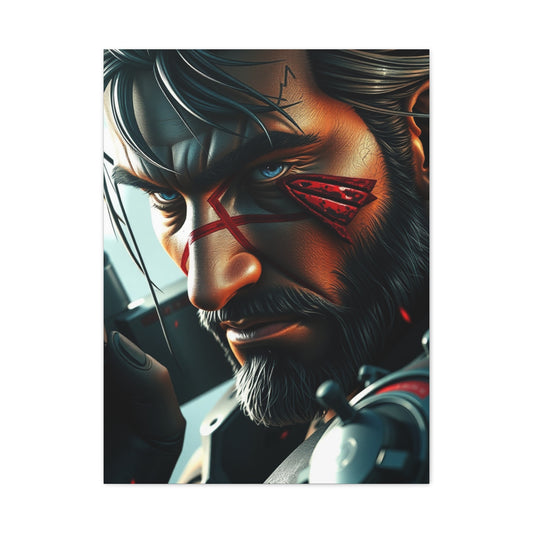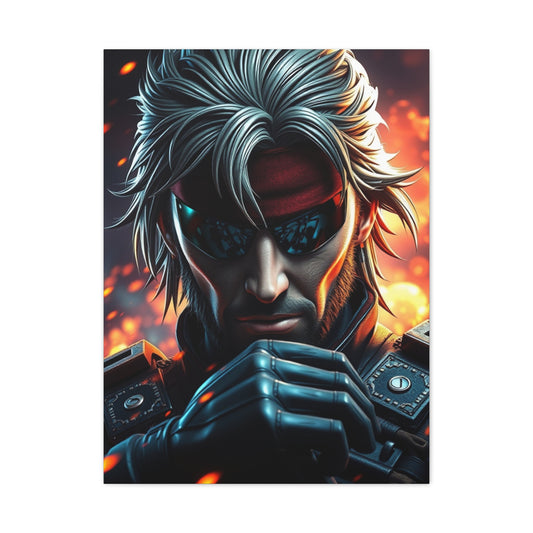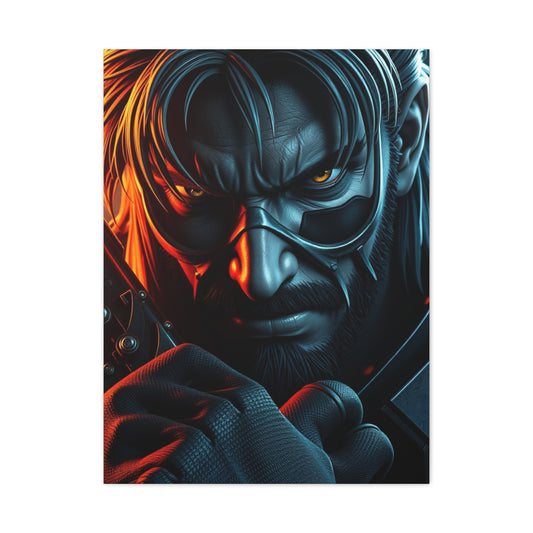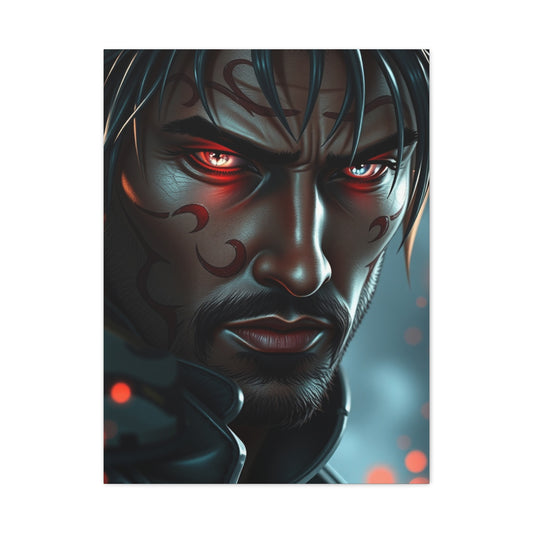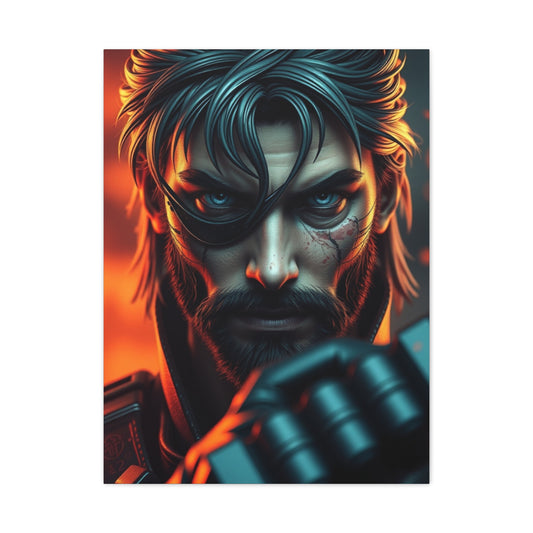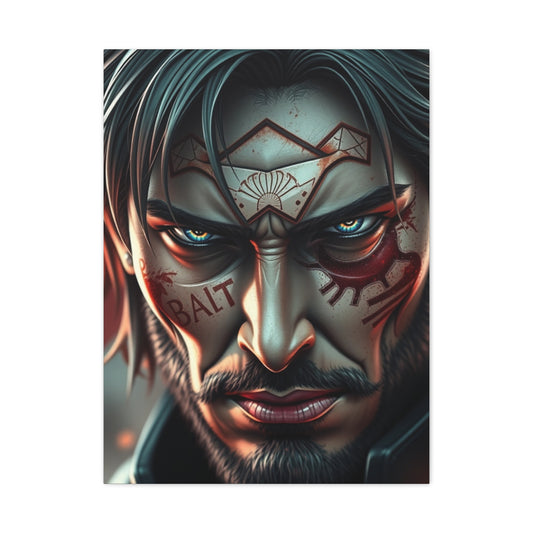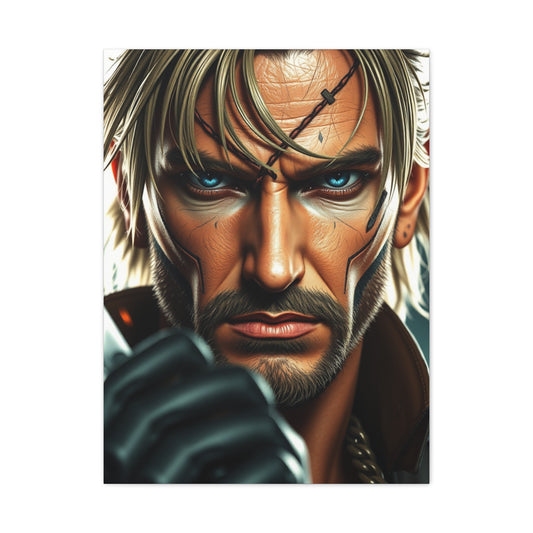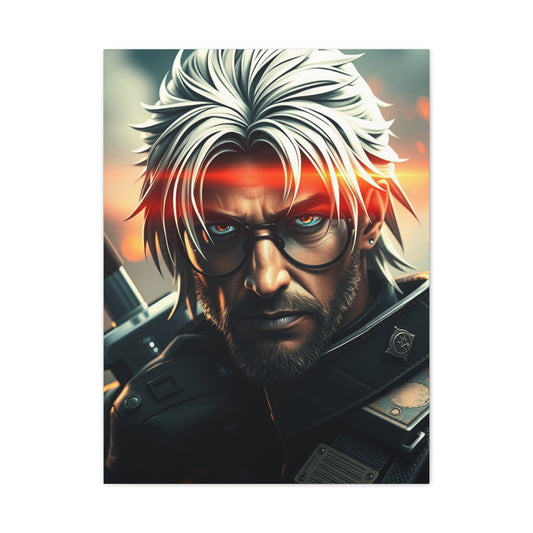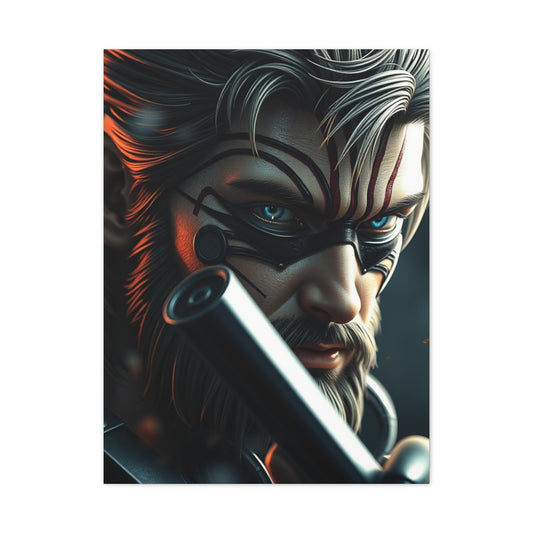Iconic Characters from Metal Gear Solid Captured in Wall Art
The Metal Gear Solid franchise has captivated gamers and artists alike for decades, inspiring countless creative interpretations that span from nostalgic pixel art to modern cyberpunk reimaginings. This comprehensive exploration delves into the rich visual culture surrounding one of gaming's most influential stealth action series, examining how fans and professional artists have transformed iconic moments, characters, and themes into stunning visual masterpieces.
Codec Screen Art Piece
The codec communication system represents one of the most distinctive visual elements of the Metal Gear series. Artists have transformed these simple communication interfaces into complex artistic statements that capture both the technological aesthetic and emotional weight of the conversations they facilitate. The stark green-on-black display aesthetic has become synonymous with covert operations and clandestine communications, making it a perfect canvas for artistic interpretation.
Modern interpretations of codec screen art often incorporate glitch aesthetics, digital noise, and fragmented visual elements that reflect the unstable nature of battlefield communications. Artists frequently layer multiple codec conversations, creating palimpsests of dialogue that represent the complex web of relationships and information that defines the Metal Gear universe. These pieces often feature distorted character portraits, fragmented text, and visual interference that suggests the precarious nature of maintaining contact during dangerous missions.
The color palette typically remains faithful to the original green monochrome aesthetic, though some contemporary interpretations introduce subtle variations in hue and saturation to create depth and visual interest. The typography becomes a crucial element, with artists often experimenting with digital fonts, spacing, and text effects that evoke the feeling of early computer terminals and military communication systems.
Artists working in this medium frequently incorporate elements of generative art and procedural creation, allowing the codec interfaces to evolve and change over time. This dynamic approach reflects the real-time nature of communication and the constantly shifting circumstances that characters face during their missions. The result is art that feels alive and responsive, capturing the tension and immediacy of tactical communication.
The emotional resonance of codec conversations has also inspired artists to create pieces that focus on specific memorable exchanges. These works often highlight moments of revelation, betrayal, or connection between characters, using visual techniques to amplify the emotional impact of key dialogue. The juxtaposition of cold, technological aesthetics with deeply personal conversations creates a powerful artistic tension that defines much of the Metal Gear experience.
Contemporary digital artists have also explored the codec interface as a metaphor for modern digital communication, drawing parallels between the isolated, mediated conversations of the game and our current experience of remote interaction through screens and devices. These interpretations often incorporate elements of social media interfaces, video calling aesthetics, and other contemporary communication tools, creating a bridge between the fictional world of tactical espionage and our daily digital lives.
Retro MGS Game Cover Design: Celebrating Classic Visual Identity
The original game covers for the Metal Gear Solid series established a visual language that continues to influence game design and pop culture imagery. Retro-inspired cover art reimagines these classic designs through the lens of different artistic periods and styles, creating pieces that honor the original while offering fresh perspectives on familiar imagery.
Many artists approach retro MGS cover designs by channeling the aesthetic of 1980s and 1990s action movie posters, with their bold typography, dramatic lighting, and heroic character poses. These interpretations often feature Solid Snake in classic action hero stances, surrounded by explosive backgrounds and dramatic shadows that evoke the feeling of cold war thriller cinema. The color palettes typically emphasize oranges, blues, and stark contrasts that were characteristic of that era's commercial art.
Alternative approaches draw inspiration from even earlier periods, creating MGS covers in the style of 1970s pulp fiction novels or 1960s spy thrillers. These versions often feature more stylized, illustrative approaches to character design, with exaggerated proportions and dramatic perspectives that emphasize the fantastical elements of the Metal Gear universe. The typography in these pieces often references classic book cover design, with serif fonts and elegant layouts that suggest literary sophistication.
Some artists have explored what MGS covers might have looked like if the games had been released during the golden age of arcade gaming, creating designs that incorporate pixel art aesthetics and bold, simple color schemes. These interpretations often feature chunky, blocky representations of characters and mecha, with layouts that prioritize clarity and immediate visual impact over subtle detail.
The retro approach also extends to alternative format explorations, with artists creating vinyl record album covers, VHS box art, and even vintage comic book covers featuring Metal Gear themes and characters. These format explorations allow artists to experiment with different aspect ratios, layout constraints, and stylistic conventions that were specific to each medium's golden age.
Typography plays a crucial role in retro cover design, with artists often recreating period-appropriate lettering styles, logo treatments, and graphic design elements. The challenge lies in maintaining the recognizable identity of the Metal Gear brand while authentically capturing the aesthetic sensibilities of different historical periods. This often involves careful research into the design trends, printing limitations, and cultural contexts that shaped visual communication during these eras.
Modern retro interpretations also frequently incorporate deliberate aging effects, such as fading, scratches, and color shifts that suggest the passage of time. These effects help create the illusion that these are genuine artifacts from gaming history, discovered and preserved by dedicated collectors and enthusiasts.
Shadow Moses Island Print: Environmental Storytelling Through Visual Art
Shadow Moses Island stands as one of gaming's most atmospheric and memorable locations, and artists have found countless ways to capture its desolate beauty and ominous atmosphere. The island's unique combination of industrial architecture, harsh natural environment, and hidden secrets provides rich material for artistic interpretation that goes beyond simple landscape representation.
Many artistic interpretations of Shadow Moses focus on the tension between the natural Alaskan wilderness and the imposing military installations that dominate the island. These pieces often feature dramatic contrasts between organic and geometric forms, using the interplay of curves and angles to suggest the uneasy relationship between human ambition and natural forces. The harsh climate and remote location are frequently represented through muted color palettes, atmospheric perspective, and weather effects that suggest isolation and vulnerability.
The industrial architecture of the island provides opportunities for artists to explore themes of power, control, and technological hubris. The massive Metal Gear REX hangar, the communications towers, and the various research facilities are often depicted with an emphasis on their imposing scale and brutalist aesthetic. Artists frequently use dramatic lighting and perspective to make these structures feel both impressive and threatening, suggesting the dangerous secrets they contain.
Environmental storytelling becomes a crucial element in Shadow Moses artwork, with artists incorporating subtle details that hint at the events that transpired on the island. Damaged infrastructure, abandoned equipment, and traces of battle are often included to suggest the human drama that played out against this forbidding backdrop. These details reward careful observation and add layers of meaning that extend beyond simple scenic representation.
The island's role as a testing ground for experimental weapons systems has inspired artists to create pieces that emphasize the location's military heritage. These works often feature technical diagrams, strategic overlays, and other elements that suggest the island's function as a nexus of military planning and weapons development. The juxtaposition of detailed technical information with the stark beauty of the landscape creates powerful commentary on the militarization of nature.
Some artists have chosen to focus on specific locations within the island complex, creating intimate portraits of spaces that held particular narrative significance. The communications towers, the underground areas, and the various laboratories each offer unique visual challenges and opportunities for atmospheric creation. These focused pieces often achieve greater emotional impact through their specificity and attention to environmental detail.
The seasonal variations of the Alaskan setting have also inspired artistic exploration, with some pieces imagining Shadow Moses during different times of year or under different weather conditions. These variations help emphasize the dynamic relationship between the permanent structures and the ever-changing natural environment, suggesting themes of endurance, adaptation, and the passage of time.
Metal Gear Art: Reduction and Essential Form
Minimalist interpretations of Metal Gear themes strip away extraneous detail to focus on essential forms, colors, and concepts. This approach often reveals new insights into familiar characters and imagery by forcing viewers to engage with simplified representations that capture the essence of complex designs through careful reduction and abstraction.
Character-based minimalist art often reduces iconic figures to their most recognizable silhouettes and color combinations. Solid Snake might be represented through a simple geometric form in military green with subtle texture suggesting fabric and equipment. The challenge for artists working in this mode is maintaining character recognition while achieving maximum visual simplicity. This often requires careful attention to proportions, gesture, and the selective inclusion of key identifying elements.
The mechanical designs of the Metal Gear series translate particularly well to minimalist interpretation, as their angular, industrial aesthetics already tend toward geometric simplification. Metal Gear REX, for example, can be reduced to a series of interconnected geometric shapes that capture its essential form and threatening presence without requiring detailed mechanical representation. These simplified versions often emphasize the psychological impact of these weapons through scale, proportion, and strategic use of negative space.
Color becomes critically important in minimalist Metal Gear art, with artists often working within severely limited palettes to achieve maximum impact. The military color schemes of the original designs lend themselves well to monochromatic or near-monochromatic treatments that emphasize form over surface detail. Strategic use of accent colors can highlight important elements or create focal points that guide viewer attention through the composition.
Typography and logo design represent another important area of minimalist interpretation, with artists creating simplified versions of the various faction emblems, unit insignia, and organizational logos that appear throughout the series. These designs often strip away decorative elements while preserving the essential symbolic content that makes these marks recognizable and meaningful within the fictional universe.
Environmental minimalism in Metal Gear art often focuses on capturing the essential atmosphere of key locations through careful selection of representative elements. Shadow Moses Island might be suggested through a simple horizon line, a few geometric shapes suggesting structures, and a limited color palette that evokes the harsh climate. These reductive approaches often achieve powerful atmospheric effects through what they choose to exclude rather than include.
The minimalist approach also lends itself well to series and variations, with artists creating multiple pieces that explore different aspects of the same subject through systematic changes in color, composition, or level of abstraction. These series often reveal new relationships between elements and can create powerful cumulative effects when viewed together.
Abstract minimalism takes the reductive approach even further, creating pieces that capture the emotional or conceptual essence of Metal Gear themes without any direct representational content. These might use color relationships, geometric forms, or compositional strategies to evoke feelings of tension, isolation, or technological anxiety that are central to the series' themes.
Cyborg Ninja Poster: Fusion of Human and Machine
The Cyborg Ninja represents one of the most visually striking and thematically complex characters in the Metal Gear universe, embodying the series' exploration of the boundary between human and machine. Artistic interpretations of this character often focus on the visual and conceptual tensions inherent in cybernetic enhancement, creating pieces that explore themes of identity, transformation, and technological transcendence.
The distinctive visual design of the Cyborg Ninja provides rich material for artistic interpretation, with its sleek, reflective surfaces and organic curves creating opportunities for complex studies in light, reflection, and form. Artists often emphasize the character's mirror-like finish through careful attention to environmental reflections and light sources, creating pieces that seem to shift and change depending on viewing angle and lighting conditions.
The integration of human and mechanical elements in the character design allows artists to explore the visual representation of enhanced capabilities and altered consciousness. Many interpretations focus on the moments of transformation or the visible seams where organic and synthetic elements meet, creating powerful imagery that speaks to broader themes of technological integration and human evolution.
Action-oriented interpretations often capture the Cyborg Ninja in moments of superhuman movement or combat, emphasizing the enhanced physical capabilities that result from cybernetic modification. These pieces frequently employ motion blur, multiple exposure effects, and dynamic composition to suggest speed and agility that exceed normal human limitations. The challenge lies in maintaining the character's essential elegance while conveying tremendous kinetic energy.
The philosophical dimensions of the Cyborg Ninja character have inspired more contemplative artistic approaches that focus on themes of memory, identity, and consciousness. These pieces often employ symbolic elements, fragmented imagery, or abstract representation to suggest the internal experience of existence as a cybernetic being. The tension between retained humanity and mechanical enhancement becomes a central visual and conceptual theme.
Some artists have explored the Cyborg Ninja through the lens of classical artistic traditions, creating pieces that reference historical sculpture, painting, or drawing techniques while addressing contemporary themes of technological transformation. These approaches often create interesting dialogue between timeless artistic concerns and cutting-edge conceptual content.
The character's role as both enemy and ally throughout the series has inspired artistic interpretations that explore moral ambiguity and shifting loyalties. These pieces often employ visual techniques that suggest duality, transformation, or internal conflict, creating complex emotional resonance that reflects the character's narrative complexity.
Technical illustration approaches to the Cyborg Ninja often focus on the fictional engineering and design principles that might govern such cybernetic systems. These pieces frequently feature cutaway views, technical diagrams, and speculative mechanical details that suggest the sophisticated technology required to create such seamless human-machine integration.
Tactical Espionage Action Canvas: Strategic Visual Narratives
The concept of tactical espionage action encompasses the core gameplay and thematic elements that define the Metal Gear experience, and artistic interpretations of this concept often focus on creating visual narratives that capture the tension, strategy, and psychological complexity of covert operations.
Environmental storytelling becomes crucial in tactical espionage art, with artists creating complex scenes that suggest multiple layers of activity, surveillance, and hidden danger. These pieces often feature multiple focal points and sight lines that encourage viewers to scan the composition for hidden details and potential threats, mirroring the heightened awareness required for successful stealth operations.
The use of shadows, concealment, and partial visibility becomes a central visual strategy in these works, with artists employing techniques that mirror the gameplay mechanics of hiding, observation, and careful movement. Figures might be suggested through silhouettes, partial glimpses, or environmental disturbances rather than direct representation, creating pieces that reward careful observation and interpretation.
Surveillance and observation imagery frequently appears in tactical espionage art, with artists incorporating elements like security camera views, perimeter scanning displays, and tactical overview maps into their compositions. These elements help create the feeling of being watched or monitored while simultaneously suggesting the tools and methods used by covert operatives to gather intelligence and plan their movements.
The psychological aspects of espionage work often find expression through visual techniques that suggest paranoia, isolation, and constant vigilance. Artists might employ fragmented compositions, multiple perspectives, or surreal elements that capture the disorienting effects of operating in hostile territory under constant threat of discovery.
Equipment and gear represent another important visual element in tactical espionage art, with artists often focusing on the specialized tools and weapons that enable covert operations. These elements are frequently portrayed with careful attention to functional detail and tactical application, suggesting the professional competence and technical expertise required for successful missions.
Communication and intelligence gathering themes appear frequently in these works, often incorporating elements like radio chatter, coded messages, or intelligence reports into the visual composition. These additions help create context for the action while emphasizing the information-based nature of modern espionage work.
Team dynamics and coordination often feature in tactical espionage art, even when individual operatives work alone. Artists might suggest the presence of support teams, command structure, or coordination through visual elements that imply connection and communication across distances. These elements help convey the collaborative nature of complex operations even when individual agents operate in isolation.
Outer Heaven Logo Wall Art: Symbolic Power and Visual Identity
The various organizational logos and emblems throughout the Metal Gear series serve as powerful symbols of factional identity, ideological commitment, and institutional power. Artistic interpretations of these symbols often explore their visual impact, symbolic meaning, and role in creating cohesive fictional universes.
The Outer Heaven logo, with its distinctive skull and crossbones motif, provides rich material for artistic exploration of themes related to rebellion, mortality, and the rejection of conventional authority. Artists often emphasize the menacing aspects of this imagery while also exploring its function as a rallying symbol for those who feel abandoned by traditional power structures.
Scale and presentation become crucial considerations in logo-based wall art, with artists needing to balance recognizability with visual impact across different sizes and viewing distances. The challenge lies in maintaining the essential character of these symbols while adapting them to different proportional relationships and spatial contexts.
Material exploration often plays a role in logo-based art, with artists experimenting with different surfaces, textures, and fabrication methods to suggest the physical reality of these symbols within the fictional universe. Metal fabrication, weathered paint, carved stone, and other material treatments can add layers of meaning related to durability, official sanction, or guerrilla application.
Historical and political symbolism embedded in these fictional logos often inspires artistic exploration of real-world parallels and influences. Artists might create pieces that examine the visual language of authority, rebellion, and factional identity across different historical periods and cultural contexts, using the Metal Gear symbols as starting points for broader investigations of symbolic communication.
Color variations and alternative presentations allow artists to explore different emotional and symbolic associations with familiar emblems. A logo presented in different color schemes or with different graphic treatments might suggest alternative interpretations of the organizations they represent, or different historical periods in their development.
Environmental integration represents another area of artistic exploration, with logo-based art often depicting these symbols in various contextual settings that suggest their role within the larger fictional universe. Whether displayed on military equipment, architectural surfaces, or propaganda materials, these contextual presentations help create more complete pictures of how these symbols function within their fictional societies.
The evolution and degradation of logos over time has also inspired artistic interpretation, with some pieces exploring how these symbols might change, weather, or be modified as their associated organizations rise, fall, or transform. These temporal explorations often create powerful commentary on the permanence and fragility of institutional power.
Snake Eater Jungle Scene: Natural Environment and Survival
The jungle settings of Metal Gear Solid 3 provide some of the most atmospheric and visually rich environments in the entire series, inspiring artistic interpretations that explore themes of survival, camouflage, and the relationship between human activity and natural ecosystems.
Dense foliage and complex layering characterize many jungle scene interpretations, with artists using overlapping forms, varied textures, and subtle color variations to create convincing representations of thick tropical vegetation. The challenge lies in creating compositions that feel authentically wild and overgrown while maintaining visual clarity and compositional structure.
Light filtration through canopy becomes a crucial element in jungle artwork, with artists often focusing on the dramatic interplay of bright shafts of sunlight and deep shadows that characterize forest environments. These lighting conditions create opportunities for atmospheric effects and can dramatically alter the mood and emotional impact of a piece.
Camouflage and concealment themes naturally emerge in jungle-based art, with artists exploring how human figures and artificial objects might blend into or contrast with natural surroundings. These explorations often mirror the gameplay mechanics of the original while creating visually compelling studies in pattern, color, and visual perception.
Wildlife integration adds another layer of complexity and authenticity to jungle scenes, with artists often incorporating the various animals and insects that inhabit these environments. These elements help create more complete ecosystems while also referencing specific gameplay elements and survival challenges from the source material.
Water elements frequently appear in jungle artwork, whether as streams, rivers, swamps, or atmospheric moisture. These aquatic features add visual interest and environmental authenticity while also suggesting the humidity and dampness that characterize tropical forest environments.
Survival equipment and shelter construction often feature in jungle-themed pieces, with artists exploring how human technology and ingenuity adapt to challenging natural environments. These elements help create narrative context while demonstrating the resourcefulness required for extended operations in hostile territory.
Temporal variations in jungle environments provide rich material for artistic exploration, with different times of day, seasons, or weather conditions creating dramatically different atmospheric conditions within the same basic setting. Dawn mist, afternoon heat shimmer, or night darkness each create unique visual opportunities and emotional associations.
Pixel-Style MGS Tribute: Retro Gaming Aesthetic
Pixel art interpretations of Metal Gear themes celebrate the aesthetic heritage of early video gaming while creating contemporary artistic statements that bridge nostalgic appreciation and modern creative expression. These works often require careful attention to the limitations and possibilities inherent in low-resolution digital art creation.
Character sprite design represents a central challenge in pixel-style MGS art, with artists needing to capture recognizable character features and distinctive costume elements within severe resolution constraints. The process often involves strategic simplification and abstraction that maintains essential visual information while discarding non-essential details.
Animation considerations frequently influence pixel art design, even in static pieces, with artists often creating character poses and compositions that suggest the potential for movement and interaction. This approach reflects the interactive heritage of the source material while creating more dynamic and engaging visual presentations.
Color palette limitations characteristic of early gaming systems often inform pixel art choices, with artists either working within historically accurate technical constraints or creating expanded palettes that maintain the essential aesthetic while allowing for greater visual sophistication.
Environmental pixel art presents unique challenges in creating convincing spatial depth and atmospheric effects within the constraints of low-resolution display. Artists often employ creative solutions involving layered scrolling backgrounds, strategic color choices, and simplified geometric forms to suggest complex three-dimensional environments.
User interface elements from classic gaming often appear in pixel-style MGS tributes, with artists incorporating health bars, inventory displays, and other interactive elements into their compositions. These additions help create more complete homages to the gaming experience while adding layers of nostalgic reference.
Technical authenticity becomes an important consideration for many pixel artists, with some choosing to work within the actual technical limitations of specific gaming systems or display technologies. These constraints can inspire creative solutions while ensuring historical accuracy in the artistic recreation of specific aesthetic periods.
Modern interpretations of pixel aesthetics often explore what classic characters and scenes might have looked like with different technical capabilities or artistic approaches, creating alternative histories that blend nostalgic appreciation with contemporary creative vision.
Metal Gear Rex Blueprint Poster: Technical Documentation as Art
The massive bipedal Metal Gear REX represents one of the most iconic mechanical designs in gaming history, and technical blueprint interpretations of this design explore themes of engineering, military power, and the aesthetic beauty of functional machinery.
Cutaway illustration techniques allow artists to reveal the complex internal systems and engineering solutions that might govern such an advanced weapons platform. These technical explorations often require careful research into real-world military technology and mechanical engineering principles to create convincing speculative designs.
Proportional accuracy and scale relationships become crucial considerations in technical blueprint art, with artists needing to suggest the massive size and imposing presence of these war machines through careful attention to human scale references and environmental context.
Annotation and technical labeling add layers of pseudo-scientific authenticity to blueprint-style artwork, with artists often creating detailed component lists, specification charts, and technical explanations that enhance the illusion of genuine engineering documentation.
Multiple view projections characteristic of professional technical drawing often appear in REX blueprint art, with artists creating orthographic projections, exploded views, and detail callouts that mirror the conventions of actual engineering documentation.
Material specifications and manufacturing details frequently feature in technical interpretations, with artists exploring what kinds of advanced materials and production methods might be required to create such sophisticated military hardware. These considerations add layers of speculative science fiction while grounding the fantastical designs in plausible technical reality.
Weaponry integration represents another area of technical exploration, with artists often focusing on the various armament systems and their integration into the overall mechanical design. These explorations might examine ammunition storage, targeting systems, and defensive measures in detailed technical presentations.
Historical context and development progression sometimes appear in blueprint-style art, with pieces exploring how the Metal Gear design might have evolved from earlier prototypes or influenced subsequent mechanical developments within the fictional universe.
Legendary Soldier Montage: Heroic Iconography and Character Study
The concept of the legendary soldier permeates the Metal Gear series, and artistic montages exploring this theme often combine multiple characters, time periods, and visual approaches to create comprehensive studies of heroism, sacrifice, and military excellence within the fictional universe.
Character juxtaposition becomes a central compositional strategy in legendary soldier montages, with artists often placing different characters in dialogue through careful positioning, scale relationships, and visual connections that suggest shared experiences or contrasting approaches to similar challenges.
Temporal layering allows artists to explore how the concept of the legendary soldier evolves across different historical periods within the series continuity. These temporal explorations might combine World War II imagery, Cold War aesthetics, and near-future speculation into unified compositions that suggest the persistence of certain heroic ideals across changing technological and political contexts.
Equipment evolution provides another organizing principle for montage compositions, with artists often showcasing how military gear, weapons, and tactical approaches have developed over time while maintaining essential functional relationships and aesthetic consistency.
Battle aftermath imagery frequently appears in legendary soldier art, with artists focusing on the costs and consequences of military excellence rather than just moments of triumph. These approaches often create more nuanced and emotionally complex presentations that acknowledge the human price of warfare.
Memorial and commemorative elements sometimes feature in these montages, with artists incorporating symbolic references to fallen comrades, completed missions, and lasting legacies. These additions help create emotional weight and suggest the broader human impact of military conflict.
Abstract symbolic elements often appear alongside representational content in legendary soldier montages, with artists using geometric forms, color relationships, or compositional structures to suggest themes of duty, sacrifice, and transcendence that might be difficult to represent through direct imagery alone.
Cross-generational connections frequently emerge as thematic elements, with artists exploring how military traditions, tactical knowledge, and ethical codes pass from one generation to the next through mentorship, example, and shared experience.
Snake vs Ocelot Duel Print: Dynamic Character Confrontation
The recurring confrontations between Solid Snake and Revolver Ocelot represent some of the most memorable and visually striking moments in the Metal Gear series, providing rich material for artistic interpretations that explore themes of rivalry, respect, and the complex relationships between skilled adversaries.
Dynamic composition becomes crucial in duel-focused artwork, with artists needing to capture the kinetic energy and split-second timing that characterizes high-level combat between expert fighters. These pieces often employ diagonal compositions, implied motion lines, and strategic use of negative space to create visual tension and suggest rapid movement.
Weapon-focused imagery often plays a central role in Snake vs Ocelot art, with the distinctive visual characteristics of their preferred armaments becoming key compositional and symbolic elements. Ocelot's ornate revolvers and Snake's practical military firearms represent different philosophical approaches to combat that artists frequently explore through careful attention to design aesthetics and tactical application.
Environmental context adds layers of meaning to duel artwork, with the specific locations and circumstances of their various confrontations providing different atmospheric and thematic frameworks. Whether set in industrial facilities, natural landscapes, or abstract conceptual spaces, these environmental choices can dramatically alter the emotional impact and symbolic meaning of the confrontation.
Psychological tension often receives as much artistic attention as physical action, with artists exploring the mental and emotional dimensions of expert-level combat through facial expression, body language, and symbolic visual elements that suggest the internal experience of these encounters.
Historical progression provides another avenue for artistic exploration, with some pieces examining how the relationship between these characters evolves across multiple encounters and changing circumstances. These temporal explorations can create more complex narrative artwork that suggests character development and changing power dynamics.
Mutual respect and professional admiration frequently emerge as themes in duel artwork, with artists often emphasizing the elements of shared understanding and appreciation that exist between skilled opponents even in moments of direct confrontation.
Technical skill demonstration becomes another focus area, with artists often highlighting the exceptional competence and precision that both characters display in their chosen specializations. These technical showcases can create educational as well as aesthetic value by illustrating advanced combat techniques and tactical principles.
MGS3 Ladder Scene Art: Vertical Journey and Symbolic Ascension
The extended ladder climbing sequence in Metal Gear Solid 3 has achieved iconic status among gaming moments, representing both a literal journey upward and a symbolic transition between different phases of the narrative. Artistic interpretations of this scene often explore themes of perseverance, transformation, and the relationship between mundane action and profound meaning.
Vertical composition naturally dominates ladder scene artwork, with artists using the elongated format to emphasize the seemingly endless nature of the climb while creating opportunities for interesting visual rhythms and proportional relationships along the vertical axis.
Atmospheric perspective becomes a crucial tool for suggesting the enormous scale of the ascent, with artists often employing subtle changes in color, contrast, and detail to create the illusion of vast vertical distance. These atmospheric effects help emphasize the physical and psychological challenge represented by the climb.
Temporal progression sometimes appears in ladder scene art, with artists creating pieces that suggest the passage of time during the extended climb through changes in lighting, weather conditions, or the character's physical state. These temporal elements help convey the duration and endurance required for the journey.
Environmental detail along the climbing route provides opportunities for visual interest and narrative context, with artists often incorporating elements of the surrounding architecture, natural features, or mechanical infrastructure that add layers of meaning and visual complexity to the basic climbing action.
Physical strain and endurance themes frequently emerge in artistic interpretations, with artists focusing on the bodily reality of extended physical exertion and the mental determination required to maintain effort over time. These human elements help ground the symbolic dimensions of the scene in recognizable physical experience.
Musical and audio associations from the original game sometimes inspire visual interpretations that attempt to capture the emotional impact of the accompanying soundtrack through color choices, rhythmic visual elements, or compositional structures that echo musical principles.
Symbolic interpretation provides rich material for abstract or conceptual approaches to the ladder scene, with artists often using the basic visual framework to explore broader themes of spiritual ascension, personal transformation, or the relationship between effort and achievement.
8-bit Solid Snake Artwork: Classic Gaming Nostalgia
Eight-bit artistic interpretations of Solid Snake celebrate the aesthetic heritage of early home gaming systems while creating contemporary artistic statements that bridge nostalgic appreciation and modern creative expression. These works often require careful attention to the severe technical limitations and distinctive visual characteristics of early digital art.
Character design simplification represents a central challenge in 8-bit artwork, with artists needing to distill complex character designs into recognizable forms that work effectively within extreme resolution constraints. This process often reveals the essential visual elements that make characters instantly identifiable.
Color palette restrictions characteristic of early gaming systems significantly impact artistic choices, with many pieces working within the limited color ranges available to historical gaming hardware. These constraints can inspire creative solutions while ensuring authentic reproduction of specific aesthetic periods.
Animation frame considerations often influence static 8-bit artwork, with artists creating character poses and expressions that suggest the potential for simple animated sequences. This approach reflects the interactive heritage of the source material while creating more dynamic visual presentations.
Environmental simplification becomes necessary in 8-bit interpretations, with complex backgrounds and settings reduced to essential geometric forms and strategic color choices that suggest three-dimensional space within two-dimensional constraints.
Sprite sheet organization sometimes appears as an artistic format, with creators developing comprehensive character representations that include multiple poses, expressions, and action states arranged in systematic grid layouts reminiscent of actual game development resources.
Technical authenticity considerations lead some artists to work within the actual specifications and limitations of specific gaming systems, creating pieces that could theoretically function as actual game graphics within their chosen technical frameworks.
Contemporary reinterpretation approaches explore what classic characters might have looked like with different artistic approaches or technical capabilities, creating alternative aesthetic histories that blend nostalgic appreciation with modern creative vision.
"Kept You Waiting, Huh
Memorable quotes from the Metal Gear series have achieved cultural significance beyond their original gaming context, and artistic interpretations of these verbal elements often explore the relationship between typography, visual design, and emotional communication.
Typography selection becomes crucial in quote-based artwork, with font choices, sizing relationships, and letter spacing all contributing to the emotional impact and visual effectiveness of the final piece. Artists often experiment with custom lettering, modified existing fonts, or completely hand-drawn type solutions to achieve optimal integration with accompanying visual elements.
Contextual imagery frequently accompanies quote-based designs, with artists incorporating visual references to the specific moments, characters, or situations that gave rise to these memorable lines. These contextual elements help ground the textual content in recognizable narrative frameworks while adding layers of meaning for informed viewers.
Color relationships and contrast become important tools for emphasizing key words or phrases within longer quotes, with artists often using strategic color choices to create visual hierarchy and guide reader attention through the textual content in specific sequences.
Background integration represents another area of artistic exploration, with some pieces treating the quote text as environmental elements within larger scenic compositions, while others focus on pure typographic presentation with minimal additional visual content.
Emotional interpretation through visual design allows artists to suggest the tone, mood, and significance of specific quotes through stylistic choices that extend beyond simple text presentation. Distressed textures, elegant flourishes, or bold geometric treatments can all contribute to the emotional communication of the verbal content.
Cultural reference and parody sometimes appear in quote-based artwork, with artists creating pieces that reference other cultural touchstones, advertising formats, or design traditions while maintaining the essential identity of the original gaming dialogue.
Interactive potential occasionally influences quote poster design, with artists creating pieces that suggest potential for animation, sound integration, or user interaction that would enhance the presentation of the textual content through multimedia approaches.
Conclusion:
The rich visual legacy of Metal Gear Solid extends far beyond the screen, embedding itself into the urban fabric and creative expression of fans and artists worldwide. Through the vibrant medium of wall art, the franchise’s iconic characters, motifs, and narrative themes have been reinterpreted and reimagined, transforming city walls and gallery spaces into living tributes that celebrate the game’s enduring impact on both gaming culture and artistic communities.
The distinct aesthetics of Metal Gear Solid—from the stark green codec screen interfaces to the brooding, tactical environments—provide fertile ground for artistic exploration. Wall artists have not only replicated these visual elements but have pushed their boundaries, blending nostalgia with innovation. The codec screen, for example, serves as more than a mere motif; it becomes a canvas for storytelling and emotional resonance. By incorporating glitch effects, layered dialogues, and digital distortions, artists evoke the tension, vulnerability, and complexity of the relationships and missions central to the Metal Gear narrative. This fusion of technology and humanity captured on walls mirrors the game’s own themes of espionage, identity, and the blurred lines between man and machine.
Similarly, retro-inspired reinterpretations of Metal Gear Solid cover art highlight how the franchise’s visual identity continues to evolve and inspire. By drawing from the aesthetics of 1980s action cinema, pulp fiction, and even classic arcade styles, artists pay homage to the original while situating the game’s characters within broader cultural and artistic traditions. This blend of past and present underscores Metal Gear Solid’s timeless appeal and the flexibility of its imagery to adapt across different eras and media formats.
Wall art based on Metal Gear Solid functions on multiple levels. It is a celebration of the game’s narrative depth and character complexity, a testament to its artistic influence, and a means of engaging public audiences who may or may not be familiar with the source material. The public placement of these works democratizes art appreciation, inviting diverse viewers to connect with the franchise’s themes of loyalty, sacrifice, and resistance. In this way, Metal Gear Solid wall art transforms urban spaces into immersive experiences that resonate emotionally and intellectually.
Moreover, the art inspired by Metal Gear Solid reflects the broader cultural significance of video games as a form of storytelling and artistic expression. These pieces challenge traditional notions of fine art, proving that video game imagery can be a powerful vehicle for cultural commentary and community identity. The collaborative and often ephemeral nature of street art also parallels the dynamic and interactive qualities of gaming itself, creating a unique dialogue between artist, audience, and source material.
As the Metal Gear Solid franchise continues to influence new generations of gamers and creatives, its presence in street art and murals ensures that its legacy remains visible, vibrant, and relevant. These visual homages serve as both personal tributes and collective memories, connecting fans worldwide through shared appreciation of the franchise’s rich characters and storytelling.
In essence, Metal Gear Solid wall art is more than decorative homage—it is an evolving cultural phenomenon that celebrates the artistry, emotion, and enduring significance of one of gaming’s most iconic series. Through these striking urban canvases, the characters and themes of Metal Gear Solid continue to captivate and inspire, proving that the medium of street art is a fitting and powerful platform for immortalizing digital legends.

